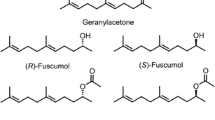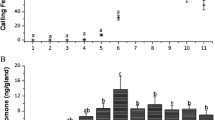Abstract
Antennae of male and femaleIps paraconfusus were equally and highly sensitive to their male-produced, multicomponent aggregation pheromone. Female and male antennae were highly sensitive to the pheromonal component, (S)-(−)-ipsenol, but essentially insensitive to its antipode, (R)-(+)-ipsenol. Further, female and male antennae were more sensitive to the pheromonal component, (S)-cis-verbenol, than to its antipode, (R)-cis-verbenol. Dramatic sexual dimorphism in chiral sensitivity to the ipsdienol enantiortiers was found, with female antennae being more sensitive to the conspecific pheromonal enantiomer, (S)-(+)-ipsdienol, and male antennae being more sensitive to the antipode, (R)-(−)-ipsdienol. Since (R)-(−)-ipsdienol is the principal pheromone of CaliforniaIps pini and interruptsI. paraconfusus aggregation, male antennae appear to be more sensitive to an interspecific allomone than a conspecific pheromone. Of the conspecific pheromonal enantiomers, both male and female antennae were most sensitive to (S)-(+)-ipsdienol, intermediately sensitive to (S)-(−)-ipsenol, and least sensitive to (S)-cis-verbenol. However, when enantiomeric sensitivities were compared to the estimated concentrations of these components in the natural pheromone, (S)-(~)-ipsenol tended to equal or approach the potency of (S)-(+)-ipsdienol as an antennal stimulant, while antennal responsiveness to (S)-cis-verbenol was dramatically less than for the other two pheromonal components. The behavioral implications of such physiological sensitivities are discussed in regard to perception of multicomponent synergistic pheromones and the relative efficacy of each component as an orientation cue.
Similar content being viewed by others
References
Adler, V.E. 1971. Physical conditions important to the reproductibility of electroantennograms.Ann. Entomol. Soc. Am. 64:300–302.
Angst, M.E., andLanier, G.N. 1979. Eiectroantennogram responses of two populations ofIps pini (Coleoptera: Scolytidae) to insect-produced and host tree compounds.J. Chem. Ecol. 5:131–140.
Bakke, A. 1976. Spruce bark beetle,Ips typographus: Pheromone production and field response to synthetic pheromone.Naturwissenschaften 63:92.
Bakke, A. 1978. Aggregation pheromone components of the bark beetleIps acuminatus.Oikos 31:184–188.
Bakke, A., Frøyen, P., andSkattebøl, 1977. Field response to a new pheromonal compound isolated fromIps typographus.Naturwissenschaften 64:98.
Birch, M.C. 1978. Chemical communication in pine bark beetles.Am. Sci. 66:409–419.
Birch, M.C., andLight, D.M. 1977. Inhibition of the attractant pheromone response inIp spini andI. paraconfusus (Coleoptera: Scolytidae): Field evaluation of ipsenol and linalool.J. Chem. Ecol. 3:257–267.
Birch, M.C., andWood, D.L. 1975. Mutual inhibition of the attractant pheromone response by two species ofIps (Coleoptera: Scolytidae).J. Chem. Ecol. 1:101–113.
Birch, M.C., Light, D.M., andMori, K. 1977a. Selective inhibition of response ofIps pini to its pheromone by the (S)-(−)-enantiomer of ipsenol.Nature 270:738–739.
Birch, M.C., Tilden, P.E., Wood, D.L., Browne, L.E., Young, J.C., andSilverstein, R.M. 1977b. Biological activity of compounds isolated from air condensates and frass of the bark beetle,Ips confusus.J. Insect Physiol. 23:1373–1376.
Birch, M.C., Light, D.M., Wood, D.L., Browne, L.E., Silverstein, R.M., Bergot, B.J., Ohloff, G., West, J.R., andYoung, J.C. 1980. Pheromonal attraction and allomonal interruption ofIps pint in California by the two enantiomers of ipsdienol.J. Chem. Ecol. 6:703–717.
Boeckh, J. 1977. Aspects of nervous coding of sensory quality in the olfactory pathways of insects, pp. 308–322,in Proceedings of XV International Congress of Entomology, 1976.
Boeckh, J., Kaissling, K.E., andSchneider, D. 1965. Insect olfactory receptors.Cold Spring Harbor Symp.Quant. Biol. 30:263–280.
Borden, J.H. 1974. Aggregation pheromones in the Scolytidae, pp. 135–160,in M.C. Birch (ed.). Pheromones. American Elsevier, New York.
Borden, J.H. 1977. Behavioral responses of Coleoptera to pheromones, allomones, and kairomones. pp. 169–200,in H.H. Shorey and J. McKelvey (eds.).Chemical Control of Insect Behavior. Wiley, New York.
Borden, J.H., Handley, J.R., Mclean, J.A., Silverstein, R.M., Chong, L., Slessor, K.N., Johnson, B.D., andSchuler, H.R. 1980. Enantiomer-based specificity in pheromone communication by two sympatricGnathotrichus species (Coleoptera: Scolytidae).J. Chem. Ecol. 6:445–456.
Brand, J.M., Young, J.C., andSilverstein, R.M. 1979. Insect pheromones: A critical review of recent advances in their chemistry, biology, and application. Prog. Chem. Org. Natural Products. 37:1–190.
Browne, L.E., Birch, M.C., andWood, D.L. 1974. Novel trapping and delivery systems for airborne insect pheromones.J. Insect Physiol. 20:183–193.
Byers, J.A., andWood, D.L. 1981. Interspecific effects of pheromones on the attraction of the bark beetles,Dendroctonus brevicomis andIps paraconfusus in the laboratory.J. Chem. Ecol. 7:9–18.
Dickens, J.C. 1978. Olfactory perception of pheromone and host-odour enantiomers byIps typographus (Coleoptera: Scolytidae).Entomol. Exp. Appl. 24:136–142.
Dickens, J.C. 1979. Electrophysiological investigations of olfaction in bark beetles.Bull. Soc. Entom. Suisse 52:203–216.
Dickens, J.C. 1981. Behavioral and electrophysiological responses of the bark beetle,Ips typographus, to potential pheromone components.Physiol. Entomol. 6:251–261.
Fish, R.H., Browne, L.E., Wood, D.L., andHendry, L.B. 1979. Pheromone biosynthetic pathways: Conversions of deuterium labelled ipsdienol with sexual and enantioselectivity inIps paraconfusus Lanier.Tetrahedron Lett. 17:1465–1468.
Hansen, K. 1983. Reception of bark beetle pheromone in the predaceous clerid,Thanasimus formicarius (Coleoptera: Cleridae).J. Comp. Physiol. In press.
Hedden, R.L., Vité, J.P., andMori, K. 1976. Synergistic effect of a pheromone and a kairomone on host selection and colonization byIps avulsus.Nature 261:696–697.
Kafka, W.A. 1976. Energy transfer and odor recognition, pp. 123–136,in G. Benz (ed.). Structure-Activity Relationship in Chemoreception. Information Retrieval, London.
Kafka, W.A., andNeuwirth, J. 1975. A model of pheromone molecule-acceptor interaction.Z. Naturforsch. 30c:278–282.
Kaissling, K.E. 1971. Insect olfaction, pp. 351–431,in L. Beidler (ed.). Handbook of Sensory Physiology, Vol. IV Chemical Senses, 1 Olfaction. Springer-Verlag, New York.
Kaisslino, K.E. 1974. Sensory transduction in insect olfactory receptors. Mosbacher Colloq. Ges. Biol. Chem. 25:243–273.
Kaissling, K.E. 1976. The problem of specificity in olfactory cells, pp. 137–148,in G. Benz (ed.).Structure-Activity Relationship in Chemoreception. Information Retrieval, London.
Lanier, G.N., andBurkholder, W.E. 1974. Pheromones in speciation of Coleoptera, pp. 161–189,in M.C. Birch (ed.). Pheromones. American Elsevier, New York.
Lanier, G.N., Claesson, A., Stewart, T., Piston, J.J., andSilverstein, R.M. 1980.Ips pini: The basis for interpopulation differences in pheromone biology.J. Chem. Ecol. 6:677–687.
Light, D.M. 1983. Sensitivity of anetnnae of male and femaleIps paraconfusus (Coleoptera: Scolytidae) to its pheromone and other behavior-modifying chemicals.J. Chem. Ecol. 9:585–606.
Light, D.M., andBirch, M.C. 1979a. Electrophysiological basis for the behavioral response of male and femaleTrichoplusia ni to synthetic female pheromone.J. Insect Physiol. 25:161–167.
Light, D.M., andBirch, M.C. 1979b. Inhibition of the attractive pheromone response inIps paraconfusus by (R)-(−)-ipsdienol.Naturwissenschaften 66:159–160.
Mitchell, B.K., andGregory, P. 1979. Physiology of the maxillary sugar sensitive cell in the red turnip beetle,Entomoscelis americana.J. Comp. Physiol. 131:167–178.
Mountcastle, V.B. 1974. Sensory receptors and neural encoding: Introduction to sensory processes, pp. 285–306,in V.B. Mountcastle (ed.). Medical Physiology, Vol. I. C.V. Mosby Co., St. Louis.
Mustaparta, H. 1979. Chemoreception in bark beetles of the genusIps: Synergism, inhibition and discrimination of enantiomers, pp. 147–158,in F.J. Ritter, (ed.). Chemical Ecology: Odour Communication in Animals. North-Holland, Amsterdam.
Mustaparta, H., Angst, M.E., andLanier, G.N. 1977. Responses of single olfactory cells in the pine engraver beetleIps pini (Say) (Coleoptera: Scolytidae) to its aggregation pheromone, ipsdienol, and the aggregation inhibitor, ipsenol.J. Comp. Physiol. 121:343–347.
Mustaparta, H., Angst, M.E., andLanier, G.N. 1979. Specialization of olfactory receptor cells to insect- and host-produced volatiles in the bark beetle speciesIps pini (Say).J. Chem. Ecol. 5:109–123.
Mustaparta, H., Angst, M.E., andLanier, G.N. 1980. Receptor discrimination of enantiomers of the aggregation pheromone ipsdienol, in two species ofIps.J. Chem. Ecol. 6:689–701.
Payne, T.L. 1970. Electrophysiological investigations on response to pheromone in bark beetles.Contrib. Boyce Thompson Inst. 24:275–282.
Payne, T.L. 1975. Bark beetle olfaction. III. Antennal olfactory responsiveness ofDendroctonus frontalis Zimmerman andD. brevicomis LeConte (Coleoptera: Scolytidae) to aggregation pheromones and host tree terpene hydrocarbons.J. Chem. Ecol. 1:233–242.
Payne, T.L. 1979. Pheromone and host odor perception in bark beetles, pp. 27–57,in T. Narahashi (ed.). Neurotoxicology of Insecticides and Pheromones. Plenum, New York.
Payne, T.L., andDickens, J.C. 1976. Adaptation to determine receptor system specificity in insect olfactory communication.J. Insect Physiol. 22:1569–1572.
Payne, T.L., andFinn, W.E. 1977. Pheromone receptor system in the females of the greater wax mothGalleria mellonella.J. Insect Physiol. 23:879–881.
Payne, T.L., Shorey, H.H., andGaston, L.K. 1970. Sex pheromones of noctuid moths: Factors influencing antennal responsiveness in males ofTrichoplusia ni.J. Insect Physiol. 16:1043–1055.
Payne, T.L., Richerson, J.V., Dickens, J.C., West, J.R., Mori, K., Berisford, C.W., Hedden, R.L., Vité, J.P., andBlum, M.S. 1982. Southern pine beetle: Olfactory receptor and behavior discrimination of enantiomers of the attractant pheromone frontalin.J. Chem. Ecol. 8:873–881.
Plummer, E.L., Stewart, T.E., Byrne, K., Pearce, G.T., andSilverstein, R.M. 1976. Determination of the enantiomeric composition of several insect pheromone alcohols.J. Chem. Ecol. 2:307–331.
Renwick, J.A.A., Hughes, P.R., andKrull, I.S. 1976. Selective production of cis- andtrans-verbenol from (−)- and (+)-α-pinene by a bark beetle.Science 191:199–201.
Roelofs, W.L. 1977. The scope and limitations of the electroantennogram technique in identifying pheromone components, pp. 147–165,in N.R. McFarlane (ed.). Crop Protection Agents. Academic Press, New York.
Roelofs, W.L., andComeau, A. 1971. Sex pheromone perception: Electroantennogram responses of the red-banded leaf roller moth.J. Insect Physiol. 17:1969–1982.
Schneider, D. 1957. Electrophysiological investigation on the antennal receptors of the silk moth during chemical and mechanical stimulation.Experientia 13:89–91.
Schneider, D. 1962. Electrophysiological investigation on the olfactory specificity of sexual attracting substances in different species of moths.J. Insect Physiol. 8:15–30.
Seabrook, W.D. 1977. Insect chemosensory responses to other insects, pp. 15–43,in H.H. Shorey and J. McKelvey (eds.). Chemical Control of Insect Behavior. Wiley, New York.
Seabrook, W.D. 1978. Neurobiological contributions to understanding insect pheromone systems.Annu. Rev. Entomol. 23:471–485.
Silverstein, R.M. 1979. Enantiomeric composition and bioactivity of chiral semiochemicals in insects, pp. 133–146,in F.J. Ritter, (ed.). Chemical Ecology: Odour Communication in Animals. North-Holland, Amsterdam.
Silverstein, R.M., andYoung, J.C. 1976. Insects generally use multicomponent pheromones.A.C.S. Symp. Ser. Pest Management with Insect Sex Attractants. 23:1–29.
Silverstein, R.M., Rodin, J.O., andWood, D.L. 1966. Sex attractants in frass produced by maleIps confusus in ponderosa pine.Science 154:509–510.
Snedecor, G.W., andCochran, W.G. 1967. Statistical Methods, 6th ed. Iowa State University Press, Iowa.
Stewart, T.E. 1975. Volatiles isolated fromIps pini: Isolation, identification, enantiomeric composition, biological activity. MS thesis. College of Environmental Science and Forestry, SUNY, Syracuse. 135 pp.
Stewart, T.E., Plummer, E.L., McCandless, L.L., West, J.R., andSilverstein, R.M. 1977. Determination of enantiomer composition of several bicyclic ketal insect pheromone components.J. Chem. Ecol. 3:27–43.
Vité, J.P. 1978. Insektenhormone im waldschutz: Erreichtes und errichbares. Biol Unsere Zeit. 4:112–119.
Vité, J.P., andFrancke, W. 1976. The aggregation pheromones of bark beetles: progress and problems.Naturwissenschaften 63:550–555.
Vité, J.P., Bakke, A., andRenwick, J.A.A. 1972. Pheromones inIps (Coleoptera: Scolytidae): Occurrence and production.Can. Entomol. 104:1967–1975.
Vité, J.P., Hedden, R., andMori, K. 1976a. Ips grandicollis: field response to the optically pure pheromone.Naturwissenschaften 63:43–44.
Vité, J.P., Klimetzek, D., Loskant, G., Hedden, R., andMori, K. 1976b. Chirality of insect pheromones: Response interruption by inactive antipodes.Naturwissenschaften 63:582–583.
Vité, J.P.,Luhl, R.,Hughes, P.R., andRenwick, J.A.A. 1976c. Pine beetles of the genus Dendroctonus: Pest populations in Central America.FAO Plant Protection Bulletin, pp. 178–184.
Wood, D.L. 1970. Pheromones of bark beetles, pp. 301–316,in D.L. Wood, R.M. Silverstein, and M. Nakajima (eds.). Control of Insect Behavior of Natural Products. Academic Press, New York.
Wood, D.L., Stark, R.W., Silverstein, R.M., andRodin, J.O. 1967. Unique synergistic effects produced by the principal sex attractant compounds ofIps confusus (LeConte) (Coleoptera: Scolytidae).Nature 215:206.
Wood, D.L., Browne, L.E., Bedard, W.D., Tilden, P.E., Silverstein, R.M., andRodin, J.O. 1968. Response ofIps confusus to synthetic sex pheromones in nature.Science 159:1373–1374.
Wood, D.L., Browne, L.E., Ewing, B., Lindahl, K., Bedard, W.D., Tilden, P.E., Mori, K., Pitman, G.B., andHughes, P.R. 1976. Western pine beetle: Specificity among enantiomers of male and female components of an attractant pheromone.Science 192:896–898.
Author information
Authors and Affiliations
Additional information
This paper is based in part upon a dissertation submitted to the University of California, Davis, in partial fulfillment of the requirements for the PhD in entomology.
Rights and permissions
About this article
Cite this article
Light, D.M. Sensitivity of antennae of male and femaleIps paraconfusus (Coleoptera: Scolytidae) to their natural aggregation pheromone and its enantiomeric components. J Chem Ecol 9, 561–584 (1983). https://doi.org/10.1007/BF00990410
Received:
Revised:
Issue Date:
DOI: https://doi.org/10.1007/BF00990410




